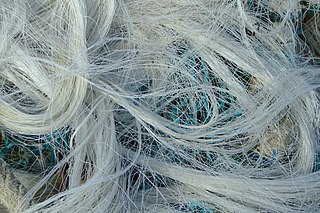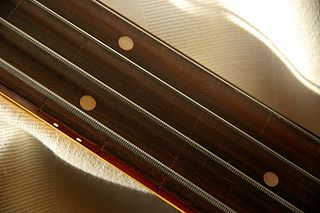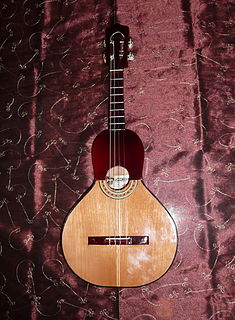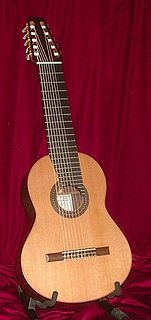History
Up until the Second World War animal gut and silk were the materials from which guitar strings were manufactured. Albert Augustine, an instrument maker from New York, USA, was the first to produce guitar strings with nylon. According to Rose Augustine, [1] his wife, he was unable to secure source materials due to the war restrictions and happened upon nylon line in an army surplus store in Greenwich Village. When initially approached by him the DuPont company, who manufactured the material, were unconvinced that guitarists would accept nylon's sonic characteristics. Augustine staged a blind test with company representatives from DuPont, they happened to choose nylon over gut as having the best "guitar sound". The DuPont company then supported Augustine's initiative. Augustine classical guitar strings were first commercially manufactured in 1948, in conjunction with Olinto Mari, President of E.& O. Mari/La Bella Strings at their factory in Long Island City New York. When Andrés Segovia, the great Spanish guitar virtuoso, discovered Augustine's strings he was an immediate convert. [2]
Fluorocarbon polymers have recently become an alternative to nylon treble strings. The sound is preferred by some luthiers and players, especially for the smooth transition provided by the G string from treble to bass. [3]

The classical guitar is a member of the guitar family used in classical music. An acoustic wooden string instrument with strings made of gut or nylon, it is a precursor of the modern acoustic and electric guitars, both of which use metal strings. Classical guitars are derived from the Spanish vihuela and gittern in the fifteenth and sixteenth century, which later evolved into the seventeenth and eighteenth century Baroque guitar and later the modern classical guitar in the mid nineteenth century.

The guitar is a fretted musical instrument that usually has six strings. It is typically played with both hands by strumming or plucking the strings with either a guitar pick or the fingers/fingernails of one hand, while simultaneously fretting with the fingers of the other hand. The sound of the vibrating strings is projected either acoustically, by means of the hollow chamber of the guitar, or through an electrical amplifier and a speaker.

Nylon is a generic designation for a family of synthetic polymers, based on aliphatic or semi-aromatic polyamides. Nylon is a thermoplastic silky material that can be melt-processed into fibers, films, or shapes. It is made of repeating units linked by amide links similar to the peptide bonds in proteins. Nylon polymers can be mixed with a wide variety of additives to achieve many different property variations. Nylon polymers have found significant commercial applications in fabric and fibers, in shapes, and in films.
Synthetic fiber or synthetic fibre are fibers made by humans through chemical synthesis, as opposed to natural fibers that are directly derived from living organisms. They are the result of extensive research by scientists to improve upon naturally occurring animal and plant fibers. In general, synthetic fibers are created by extruding fiber-forming materials through spinnerets, forming a fiber. These are called synthetic or artificial fibers. Synthetic fibers are created by a process known as polymerization, which involves combining monomers to make a long chain or polymer. The word polymer comes from a Greek prefix "poly" which means "many" and suffix "mer" which means "single units".. There are two types of polymerization: linear polymerization and cross-linked polymerization.

A guitar pick is a plectrum used for guitars. Picks are generally made of one uniform material—such as some kind of plastic, rubber, felt, tortoiseshell, wood, metal, glass, tagua, or stone. They are often shaped in an acute isosceles triangle with the two equal corners rounded and the third corner less rounded. They are used to strum chords or to sound individual notes on a guitar.

The seven-string guitar adds one additional string to the more common six-string guitar, commonly used to extend the bass range or also to extend the treble range.

Catgut is a type of cord that is prepared from the natural fibre found in the walls of animal intestines. Catgut makers usually use sheep or goat intestines, but occasionally use the intestines of cattle, hogs, horses, mules, or donkeys. Despite the name, catgut manufacturers do not use cat intestines.

Fingerstyle guitar is the technique of playing the guitar or bass guitar by plucking the strings directly with the fingertips, fingernails, or picks attached to fingers, as opposed to flatpicking. The term "fingerstyle" is something of a misnomer, since it is present in several different genres and styles of music—but mostly, because it involves a completely different technique, not just a "style" of playing, especially for the guitarist's picking/plucking hand. The term is often used synonymously with fingerpicking except in classical guitar circles, although fingerpicking can also refer to a specific tradition of folk, blues and country guitar playing in the US. The terms "fingerstyle" and "fingerpicking" also applied to similar string instruments such as the banjo.

Monofilament fishing line is fishing line made from a single fiber of plastic, as opposed to braided fishing line constructed from multiple fibers of material. Most fishing lines are now monofilament because monofilament fibers are cheap to produce and are produced in a range of diameters which have different tensile strengths. Monofilament line is also manufactured in different colors, such as clear, white, green, blue, red, and fluorescent.
D'Addario is a manufacturer of musical instrument strings and accessories, primarily for guitars but also many other fretted and orchestral instruments. The company currently has its world headquarters in Farmingdale, Long Island, New York, and its European headquarters in Newcastle upon Tyne, England. It is a family-owned and operated business that is one of the largest string manufacturers in the world, not only producing several lines of strings under their own brand names, but also making OEM strings for other musical instrument companies.

The Russian guitar (sometimes referred to as a "Gypsy guitar") is an acoustic seven-string guitar that was developed in Russia toward the end of the 18th century: it shares most of its organological features with the Spanish guitar, although some historians insist on English guitar ascendancy. It is known in Russian as the semistrunnaya gitara (семиструнная гитара), or affectionately as the semistrunka (семиструнка), which translates to "seven-stringer". These guitars are most commonly tuned to an open G chord as follows: D2 G2 B2 D3 G3 B3 D4. In classical literature, the lowest string (D) occasionally is tuned down to the C.

A string is the vibrating element that produces sound in string instruments such as the guitar, harp, piano, and members of the violin family. Strings are lengths of a flexible material that a musical instrument holds under tension so that they can vibrate freely, but controllably. Strings may be "plain", consisting only of a single material, like steel, nylon, or gut, or wound, having a "core" of one material and an overwinding of another. This is to make the string vibrate at the desired pitch, while maintaining a low profile and sufficient flexibility for playability.

The bandola is one of many varieties of small pear-shape chordophones found in Venezuela and Colombia. They are related to the bandurria and mandolin.
A setar, also spelled and romanized as setaar or setâr, is an Iranian musical instrument. It is a member of the lute family. It is played with the index finger of the right hand. The range of the setar spans more than two and a half octaves.

A violin consists of a body or corpus, a neck, a finger board, a bridge, a soundpost, four strings, and various fittings. The fittings are the tuning pegs, tailpiece and tailgut, endpin, possibly one or more fine tuners on the tailpiece, and in the modern style of playing, usually a chinrest, either attached with the cup directly over the tailpiece or to the left of it. There are many variations of chinrests such as clamped to the body in the center, on either side of the tailpiece as with a Guaneri style chinrest or to the left of the tailpiece.
In tennis, the strings are the part of a tennis racquet which make contact with the ball. The strings form a woven network inside the head of the racquet. Strings have been made with a variety of materials and possess varying properties that have been measured, such as dynamic stiffness, tension retention, thickness (gauge), string texture, and rebound efficiency.

A classical guitar with additional strings is a nylon-string or gut-string classical guitar with more than six strings, in which the additional strings pass over a fingerboard so that they may be "stopped" or fretted with the fingers. These are also known as extended-range guitars, and should not be confused with harp guitars.
The strings of the guqin Chinese zither are either made of silk, nylon or metal-nylon.

There are many varieties of ten-string guitar, including:
Albert Augustine Ltd. is the originator of and currently a manufacturer of nylon classical guitar strings. In addition, the company supports the classical guitar and guitarists by presenting several annual New York guitar series at the Manhattan School of Music, the Queen Sofia Spanish Institute and other important venues, by commissioning hundreds of original solo and chamber music works and concertos from some of the foremost contemporary composers, by donating thousands of dollars for scholarships, special artist's projects and guitar festivals, and by publishing Guitar Review magazine.













